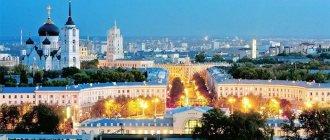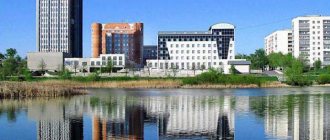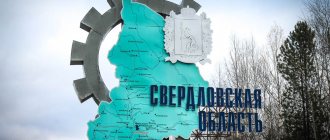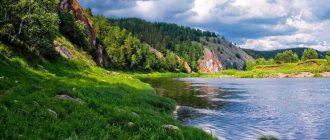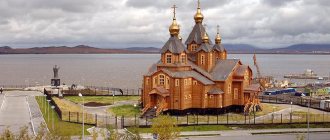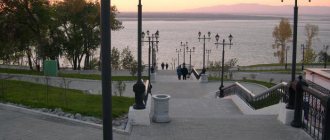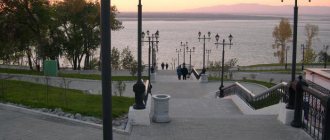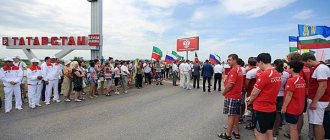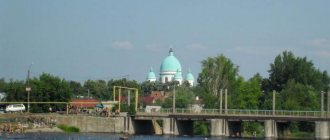Save it for yourselfPrint
The Amur Region is located in the southeast of the Russian Federation and is part of the Far Eastern District. In 1948 it was separated as a separate administrative unit. The Amur region is the country's southern border with the People's Republic of China.
The region also borders: in the west with the Trans-Baikal Territory, in the north with the Republic of Sakha, it is also called Yakutia, in the east with the Khabarovsk Territory, and in the southeast with the Jewish Autonomous Region. The Amur region is represented by a medium-sized territory, which occupies more than 300 thousand square kilometers.
Landscapes of the Amur region
The region's territory is represented predominantly by mountainous terrain and is expressed by a chain of mountain ranges giving way to plains. The main ridge is located in the north of the Amur region - Stanovoy, the height of the mountains reaches more than 2000 meters above sea level. Parallel to this ridge rises another chain of ridges: Tukuringra, Dzhagdy, Soktahan, Yankan.
Predominantly mountainous terrain lies along the eastern border. The southern part of the Amur region is represented by a large area of plains. The name of the region comes from the largest river that flows in this region - the Amur, with its large tributaries Zeya and Burya. The Zeya Reservoir is located in the center of the Amur Region.
Small towns up to 20 thousand people
Shimanovsk
Population 18,566 people (2020).
Raichikhinsk
Population 16,784 (2020).
Zavitinsk
Population 10,215 (2020).
Skovorodino
Population 8,943 (2020).
Tsiolkovsky
This name has other meanings, see Tsiolkovsky. See also Uglegorsk.
Population 7,188 (2020). A closed city for personnel serving the Vostochny cosmodrome. It received city status in 2015, and it included the former closed urban settlement of Uglegorsk.
Climate of the territory
The Amur region is located in a temperate geographical zone. The climate of the territory is varied with a large temperature difference. Winter in this region is harsh with temperatures below freezing. The northern part of the region is equated to the regions of the Far North, due to its remoteness from the sea and close proximity to mountain systems.
In winter, temperatures throughout the territory range from minus 20 to minus 40 degrees. A special feature is the slight snow cover. But summer throughout the Amur region is marked by high temperatures and large amounts of precipitation. The temperature ranges from 20 to 40 degrees plus, but in mountainous areas the temperature reaches plus 15 degrees.
Flora and fauna of the Amur region
The flora and fauna of the region is very rich and diverse. In different parts of the region you can find harsh taiga, mixed coniferous forests, and wide steppe with solitary trees. In the south of the Amur region, heat-loving plants grow and are represented by lemongrass, feather grass, Amur velvet and cedar pine.
The taiga of this harsh region is represented by the following plant species: spruce, fir and stone birch. Rhododendron, dwarf cedar, cassiopeia and other species grow in mountainous areas. Pine and Mongolian oak also grow in the region.
The fauna of this territory is represented by a rich variety of rare species. Here you can find brown bears, foxes, wolves, reindeer, Amur tigers, falcons, eagles, wapiti, Amur leopards and a large number of fish species.
see also
- Amur region
- Symbols and landmarks of the Amur region
- Cities of Russia
| [ + ] Cities by regions of Russia | |
| Cities of the North-West (NWFD) | St. Petersburg (and its cities) • Leningrad region (historical Staraya Ladoga) • Arkhangelsk region • Vologda region • Kaliningrad region • Karelia • Komi • Murmansk region • Nenets Autonomous Okrug • Pskov region |
| Cities of the Volga region (Volga Federal District) | Bashkortostan • Volgograd region • Kalmykia • Kirov region • Mari El • Mordovia • Nizhny Novgorod region • Orenburg region • Penza region • Perm region • Samara region • Saratov region • Tatarstan • Udmurtia • Ulyanovsk region • Chuvashia |
| Cities of Southern Russia (SFD) | Sevastopol (including Inkerman) • Republic of Crimea • Adygea • Astrakhan region • Krasnodar region • Rostov region |
| Cities of the North Caucasus (NCFD) | Dagestan • Ingushetia • Kabardino-Balkaria • Karachay-Cherkessia • North Ossetia - Alania • Stavropol Territory • Chechen Republic |
| Cities of the Urals (Ural Federal District) | Kurgan region • Sverdlovsk region • Tyumen region • Khanty-Mansi Autonomous Okrug - Yugra • Chelyabinsk region • Yamalo-Nenets Autonomous Okrug |
| Cities of Siberia (Siberian Federal District) | Altai Republic • Altai Territory • Irkutsk Region • Kemerovo Region • Krasnoyarsk Region • Novgorod Region • Novosibirsk Region • Omsk Region • Tomsk Region • Tyva • Khakassia |
| Cities of the Far East (FEFD) | Amur Region • Buryatia • Jewish Autonomous Region • Trans-Baikal Territory • Kamchatka Territory • Magadan Region • Primorsky Territory • Sakha (Yakutia) • Sakhalin Region • Khabarovsk Territory • Chukotka Autonomous Region |
| see also | Cities of the DPR, LPR, Transnistria, South Ossetia • Regions of Russia • Cities of Russia |
Tourism of the region
Tourism in this unique area is just beginning to develop. The unusual and unique landscapes of the territory attract many tourists to visit the Amur region. The wonderful combination of mountain ranges and deep rivers makes it possible to develop eco-tourism. There are a large number of nature reserves located on the territory of the Amur Region, almost all of them provide interesting excursions to incredibly beautiful protected areas. Also, many tourists come here for good fishing and hunting.
Save it for yourselfPrint
Author of the publication
offline for 3 days
Urban settlements
- Magdagachi
Population 9,895 (2020).
- Progress
Population 9,517 (2020).
- Seryshevo
Population 9,438 (2020).
- Arhara
Population 8,508 (2020).
- Novobureysky
Population 6,688 (2020).
- Fevralsk
Population 4,560 people (2020).
- Erofey Pavlovich
Population 4,438 (2020).
- Talakan
Population 4,139 (2020).
- Bureya
Population 4,021 (2020).
- Urusha
Population 3,262 (2020).
- Ushumun
Population 1,899 (2020).
- Novoraichikhinsk
Population 1,842 people (2020).
- Sivaki
Population 1,568 people (2020).
- Ekimchan
Population 986 people (2020).
- Tokur
Population 816 people (2020).
Population
It's hard to believe, but in the mid-nineteenth century the total population of these lands (according to the census) was only 2950 people! Imagine an area of Germany where such a handful of people live!
But every year the population increased and by the end of the 19th century almost 100 thousand people lived here. On the eve of the Great Patriotic War, almost 700 thousand residents already lived here. Alas, the terrible war greatly reduced the population: people from here became a real nightmare for the German invaders, but they themselves died en masse in the most dangerous sectors of the front line. The post-war population was only 450 thousand people.
But in subsequent years, until the collapse of the USSR, the population increased and by the end of the 80s it exceeded a million. Since then, every year the number of people has only decreased; positive dynamics have never been recorded. Today less than 800 thousand people live here.
Of these, 94% are Russian people. Second place remains with Ukrainians – about 2%. Belarusians are in third place – 0.5%. The Armenians are only slightly inferior to them - 0.48%. Also here you can see Azerbaijanis, Tatars, Uzbeks, Germans and representatives of many other nationalities. Among the local tribes, Evenks, Buryats, Yakuts and others live here.
Economy of the region
Despite the fact that the region is experiencing economic stagnation, there are hopes for rapid change caused by the implementation of several large projects.
The most significant recent project is the construction of a gas processing plant, which should become one of the largest in the entire Far East and significantly increase gas exports from Russia.
The second important enterprise that appeared in the region is the Vostochny cosmodrome, which should become an alternative site to Baikonur, located on the territory of Kazakhstan.
History of the region's development
Despite the fact that the first armed detachments of Russian pioneers managed to gain a foothold on the banks of the Amur, local residents nevertheless regained power over the lands, turning to the Manchu dynasty of China for support, under whose rule the Far Eastern lands remained for the next two centuries.
In the 19th century, China weakened significantly as the empire began to have internal problems and European colonial powers began actively invading its southern possessions. Thus, the region where the Amur region is located came under the control of the Russian Empire in the second half of the 19th century, and already in 1858 the administrative boundaries of this region were determined.
Blagoveshchensk is the administrative center of the region
The region in which Blagoveshchensk is located in the Amur region is determined by the charter of the region and its administrative division. From an administrative point of view, Blagoveshchensk is the administrative center of the Blagoveshchensky district. From the center of the region to Moscow 7985 kilometers by rail and 6480 kilometers by plane.
Blagoveshchensk was founded in 1856, when the entire region where the Amur region is located began to be actively colonized by Russian Cossacks. Today the city's population is more than 220 thousand people. The city has several large factories built during the Soviet Union, but the most dynamically developing enterprises are in the service and trade sectors.
Excursion into history
Monuments about the first people who lived in these areas date back to the 11th millennium BC. Various tribes lived here, from the Paleolithic to the Neolithic.
Russian people came here in the middle of the seventeenth century, or more precisely, in 1644. It was then that Vasily Poyarkov arrived here with a detachment. Despite numerous clashes with the local people - the Daurs, who were supported by the Manchus, they managed to gain a foothold and create the Albazin Voivodeship. Over time, the Aigun Treaty was concluded and these lands were officially assigned to Russia.
During the Civil War, these lands became part of the Far Eastern Republic. But in 1922 it became part of the RSFSR, and more specifically, the Far Eastern Territory. In 1938, the administrative unit was divided into Primorsky and Khabarovsk territories, these territories became part of the latter. Finally, in 1948, the Amur region was separated as a separate administrative unit, which it remains to this day.
A little geography
To begin with, it is worth saying that the area of the Amur region in square meters. km is quite large - almost 362 thousand. That is, approximately the same as Germany or almost four times Portugal. The region is located in the southeast of the country, right on the border with China.
It stretches strongly from north to south, so the climate varies significantly. In the north-west, sharply continental climate prevails: summers are hot and dry, and winters are quite cold, with a lot of precipitation. But in the southeast, a completely different picture is observed: the great influence of air masses from the Pacific Ocean creates a monsoon climate, characterized by large amounts of precipitation in summer and little in winter.
In winter, the average minimum temperature ranges from -22 to -31 degrees: such a difference is not surprising if we recall the total area of the Amur region. The recorded absolute minimum was -45 degrees Celsius. But the summer is hot: in the north the temperature sometimes reaches +38 degrees, and in the south - +40 degrees. True, in high mountain areas the average temperature in summer is only +12 degrees.
The entire territory is divided into 20 districts. Moreover, the area of the districts of the Amur region is very different: from 2,510 square kilometers (Tambovsky) to 87,500 (Zeysky).
